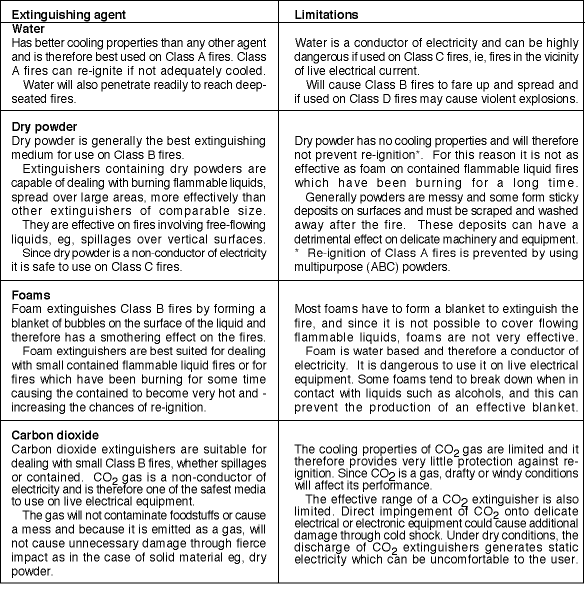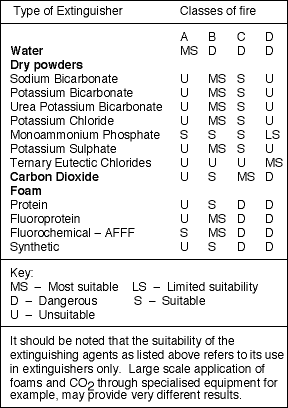
Most fires, if detected early enough, can be easily extinguished through the prompt application of the correct type and appropriate quantity of extinguishing agent. Portable fire extinguishers are designed to fulfil this purpose provided they contain the most suitable extinguishing agent for the risk being protected.
There are several factors concerning portable fire extinguishers which, if implemented during pre-planning, will give the user every chance of successfully extinguishing a fire during those first few minutes.
Factors affecting your choice
The following factors need to be considered to ensure that the correct extinguisher is selected.
* The type of combustible material on site. Some extinguishers can be used on a variety of combustible materials, but they may have a limited suitability on specific materials. Reference to suitability appears later in this article.
* The possible size of a fire. Some extinguishers, while effective on contained flammable liquids fires, are not capable of dealing with the same amount of liquid if it is spilt over a large area.
* Physical abilities of the operator. Carbon dioxide extinguishers can have a mass of up to 34 kg for only 12 kg of content and would therefore be far too heavy and cumbersome for use by most people especially women. It would be preferable to install several smaller units in these circumstances.
* The environment of the extinguisher: Extreme temperatures or excessive vibration may be detrimental to some extinguishers.
* Maintenance requirements: In outlying areas empty extinguishers may have to be sent away for long periods to be recharged.
* Standardisation: It would be wise to standardise on extinguishers which, even though differing in their content, would operate in the same manner. This would have distinct advantages in the training of staff who may not be able to regularly attend instruction sessions or practical drills.
Classification of fires
The selection of extinguishing media for any risk is further simplified by classifying fires according to type.
Fires involving combustible materials that require the same extinguishing media are grouped together and are defined in the South African Bureau of Standards Code of Practice 0105 titled 'Code of Practice for the Classification, Use and Maintenance of Portable Fire Extinguishers'.
The classes are:
Class A
Fires involving ordinary solid combustible materials, eg, coal, paper, plastics, wood and textiles.
Class B
Fires involving flammable liquids and gases eg, alcohols, benzene, oils, paraffin, petrol, LPG, hydrogen, acetylene.
Class C
Fires of Class A, B or D type occurring in the presence of live electrical installation, eg: electrical cables, generators, transformers, switchboards.
Class D
Fires involving metals eg, aluminium, magnesium, sodium, potassium and lithium.
Extinguishing media
The design of the extinguisher itself may affect its extinguishing capabilities, but the selection of the correct extinguisher is determined by the extinguishing agent. The following is a brief summary of the advantages and limitations of the extinguish media commonly used in portable extinguishers.

Suitability
The table provides a guide to the effectiveness of various extinguishing agents on different classes of fire.

Reference: Fire Protection Association of Southern Africa.

© Technews Publishing (Pty) Ltd. | All Rights Reserved.